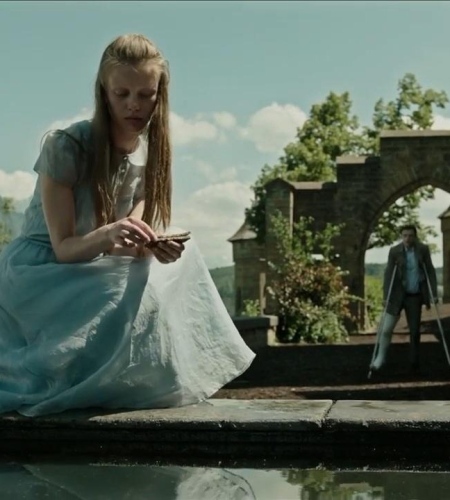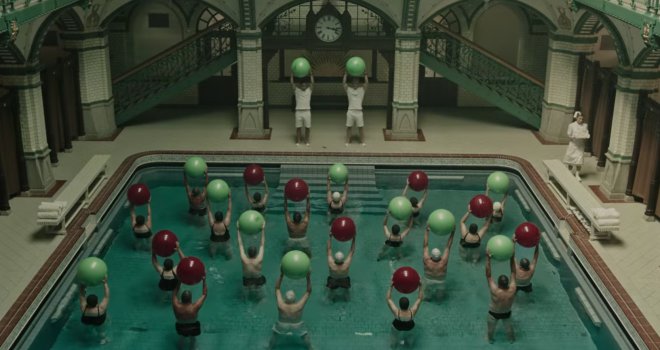 February has not been a good month for movies. One bright spot was A Cure for Wellness, directed by Gore Verbinski and written by Justin Haythe. Verbinski directed the first three Pirates of the Caribbean films, The Ring, and Rango, and Haythe is mostly known for adapting Revolutionary Road for the screen. A Cure for Wellness is a classic Gothic tale, with elements of Frankenstein, Phantom of the Opera, and “The Fall of the House of Usher.”
February has not been a good month for movies. One bright spot was A Cure for Wellness, directed by Gore Verbinski and written by Justin Haythe. Verbinski directed the first three Pirates of the Caribbean films, The Ring, and Rango, and Haythe is mostly known for adapting Revolutionary Road for the screen. A Cure for Wellness is a classic Gothic tale, with elements of Frankenstein, Phantom of the Opera, and “The Fall of the House of Usher.”
A Cure for Wellness centers on an ambitious young Wall Street executive named Lockhart (Dane DeHaan), who is sent to retrieve his company’s CEO, Roland Pembroke (Harry Groener), from a health spa/hospital built on castle ruins at a remote location in the Swiss Alps. Once there, he breaks his leg in a car accident, and the director, Dr. Heinreich Volmer (Jason Isaacs), invites him to stay and partake in “the cure.”
Over the course of a few days, he learns the castle’s gruesome history, and meets a mysterious young woman named Hannah (Mia Goth). Two hundred years ago, the castle’s baron tried to conceive a child with his sister to keep the family bloodline pure. The outraged villagers stormed the castle, murdered the baroness, and burnt the castle to the ground. All is not what it seems at Volmer Institute, and Lockhart must get to the bottom of it before it claims him as well.
There’s a lot going on in this movie. Philosophically, it criticizes modern society and treats ambition as a disease. One character literally works himself to death in the opening credits, and wealthy patients flock to the Volmer Institute and its idyllic surroundings to avoid a similar fate. There is a stark contrast between the “pure,” romantic world of the Institute, and the village below, with its dirty residents and nihilistic youth.
As the villagers once burned the castle in anger, we have, Dr. Volmer argues, overthrown aristocracy and dethroned God, so all we have left is to worship naked ambition. Dr. Volmer, however, is no crusader. He exploits this modern condition to satisfy motives that are, shall we say, less than pure.
By playing on common fears of contaminated drinking water, and inverting water as a symbol of purity, the film tugs at a primal thread. In this movie, we are asked to fear the very thing that keeps us alive.
A Cure for Wellness maintains a creepy atmosphere throughout. I love the contrast between the castle ruins, mountains, and scenery, and the sterile, bureaucratic, distinctly early-twentieth century hospital. In many ways, it reminded me of The Road to Wellville (1994), which lampooned the quackery of John Harvey Kellogg and other turn-of-the-century health nuts.
The film is not without its flaws. At the risk of sounding nitpicky, the CGI elk Lockhart and his driver run into is terrible. There’s no excuse for a CGI animal this bad in a movie made in 2016. Watching the poor animal flop around on the pavement doesn’t add anything to the film, and it would have been scarier if we didn’t know what kind of animal they hit.
More importantly, A Cure for Wellness doesn’t work as a mystery. In a good mystery, the audience discovers clues alongside the protagonist. The thrill comes from an “ah-hah” moment, as the clues begin to fit together. In this film, Lockhart largely “solves the mystery” by being spoon fed answers, sometimes by other patients. If Dr. Volmer wanted to make sure no one discovered what he was doing, why did he leave historical books, records, and articles just lying around where patients could collect them and piece together the castle’s terrible history?
 Finally, Hannah’s character is grossly mishandled. The writer and director inexplicably reduced her role to a pretty set piece, a pawn who is just kind of “around,” when she is, in reality, central to the whole story.
Finally, Hannah’s character is grossly mishandled. The writer and director inexplicably reduced her role to a pretty set piece, a pawn who is just kind of “around,” when she is, in reality, central to the whole story.
Without Hannah, the movie’s central events wouldn’t have taken place. **Spoilers** Hannah, it turns out, is the baron (Dr. Volmer)’s daughter. He has been using elderly patients to distill a cure for aging, keeping himself and his daughter alive until she reaches puberty and can become his bride and continue the family bloodline.
Dr. Volmer has kept her in the dark about their true identities. She thinks she is sick, and her father will come get her as soon as she’s well. After over a century, however, wouldn’t she start asking questions about her origins, why she’s aging so slowly, why all these other people keep dying, or what exactly is wrong with her?
A Cure for Wellness would have been immensely improved if Hannah, not Lockhart, was the protagonist trying to solve the mystery. The arrival of a handsome young man could have been the catalyst that awakened her desire to finally leave, and Dr. Volmer would try to keep Lockhart from helping Hannah discover the awful truth. Instead, she mostly just wanders around looking vacant.
Ultimately, this film is visually and thematically interesting, and a cut above its peers. The mostly foreign supporting cast is great. I appreciated seeing a cameo by Michael Mendl, a German television actor who played General Weidling in Downfall (2004). By making Lockhart the protagonist, the filmmakers missed an opportunity for a more compelling story, but it’s still a solid psychological thriller.


5 replies on “A Cure for Wellness”
[…] and not as creepy or reptilian as he was in Valerian and The City of a Thousand Planets or A Cure for Wellness. Once again, Molly Shannon and John C. Reilly play awkward adults in a Jeff Baena film. It […]
LikeLike
Thanks! Good luck in your art
LikeLike
I’m glad someone else noticed the resemblance to “The Fall of the House of Usher” as it was incredibly prevalent. The movie itself had a great concept and beautiful cinematography, but was poorly executed in terms of plot. You truly kept the review of this movie “Kleen” and precise. Good Job. Regards, a future director.
LikeLike
[…] DeHaan, who played Major Valerian, basically reprised his role in A Cure for Wellness (2016), which doesn’t bode well for his acting range. He lacked a personality in both […]
LikeLike
[…] my review of A Cure for Wellness (2016), I argued that in a good mystery, the audience discovers clues alongside the protagonist. […]
LikeLike